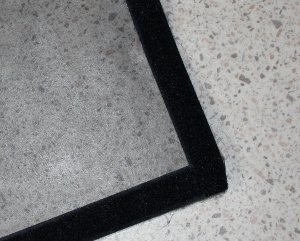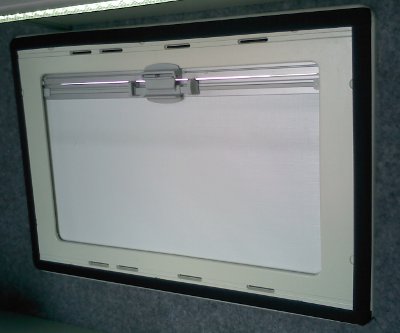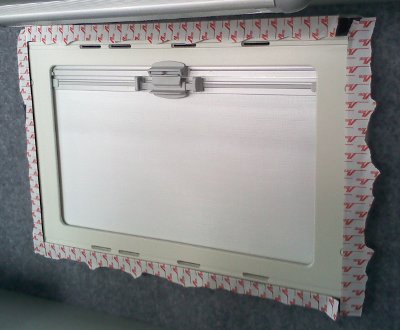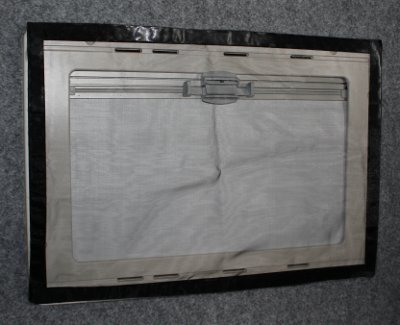How To: Make Midge-Proof Fly Screens For Motorhome Windows
Our last two summer holidays have been to destinations where midges are a fact of life in summer (Scotland and Norway).
As you may know, midges do bite (albeit mildly) and tend to appear in droves when the weather is wet, warm and still – times when you really need to be able to open your motorhome’s windows, especially in a small van.
You may also know that midges are remarkably small – so small that they can pass with ease through standard insect netting, as found in most motorhome windows (e.g. Seitz windows with integrated blinds and fly screens). Midges are attracted by CO2, so breathing is enough to attract them to you, especially if you have a light on too (they like lights as well).
If you smoke a lot (midges don’t like smoke), have skin like leather or just don’t care about being bitten, you can stop reading now. If not, read on and I will explain how we created midge proof screens for our windows without spending more than a few pounds.
Making Midge Screens For Motorhome and Caravan Windows
What we decided to do was to make additional midge screens that could be fixed with velcro to the inside frames of our motorhome windows, whenever we needed them. This turned out to be cheap, simple and very effective against midges.
Midge Netting
Proper midge netting that is designed for fitting to the windows of buildings is made from fibreglass and is quite expensive – around £15 per square metre (e.g. here). It is doubtless good stuff but a bit over the top for motorhome windows.
What we used instead was fine fabric netting, of the kind that is used to make insect-proof head nets. We purchased our midge netting from www.midgie.net who sell packs of lightweight midge netting (I think it’s nylon?) in various sizes, starting from 1.1mx1.5m for £4.99 (click here).

We also bought several metres of self-adhesive velcro from a local shop – enough to go around the frame of each window needing a screen.
Making The Midge Screens
1. Choose one side of the velcro to use on the window frames and one side to use on the midge netting. It doesn’t matter which is which, but bear in mind that the rough side of the velcro will stick to wall lining carpet.
2. Stick a strip of velcro around each of your window frames, taking care to get a good join at the corners so there are no gaps for midges to come through:

3. Now cut identical length pieces from the other half of the velcro, and stick them onto the window frames, without removing the backing paper on the sticky side:

3. Measure the size of your windows and cut out a piece of midge netting for each window that is a bit bigger than necessary. You can trim the surplus netting away after you have stuck it to the velcro – this is the easiest method to get the netting exactly the right size, as it is quite stretchy and flimsy.
4. Finally, peel the backing paper away from the velcro on the window frame and stick the midge netting to it, leaving a small amount spare on each side. I would recommend doing this in stages to avoid having the netting stick where it shouldn’t. Start at the top and remove the backing paper in stages, with the bottom edge last.
The trick is to pull it tight enough to avoid folds but not so tight as to be stretched:

Once you have stuck the netting on, run your finger around the edge to make sure it is fully stuck down and then leave it in place on the window for a few hours to allow the adhesive to dry off a bit.
Fitting and Removing The Midge Screens
We found that our midge screens worked well and were robust enough to stand being fitted and removed regularly. However, they will not stand up to rough handling and the netting can come away from the velcro if you pull on it.
The key is to remove the screens gradually, always lifting them up by putting your fingers underneath the velcro and gradually pulling it away from the window frame.
Spraying The Netting – An Extra Refinement
We found that this midge netting completely stopped midges coming into the van – but they did still settle in great numbers onto the outside of the netting. This is not a big problems – just blow them off before removing the nets to close the window.
However, one way of improving this situation is to spray the netting with a midge-repellent spray. We gave the netting a light coating of our Avon spray* and it worked even better, deterring many midges from settling on the netting.
*When out and about in particularly midge-infested areas of Scotland, we’ve used Avon’s Skin So Soft Original Dry Oil Body Spray to ward off the bugs. It contains citronella and works well in our experience – much nicer than using a DEET spray. Mind you, the smell of the spray is such that I can’t imagine using it at any other time!
